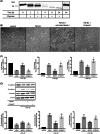Disruption in the balance between apolipoprotein A-I and mast cell chymase in chronic hypersensitivity pneumonitis
- PMID: 33016012
- PMCID: PMC7654418
- DOI: 10.1002/iid3.355
Disruption in the balance between apolipoprotein A-I and mast cell chymase in chronic hypersensitivity pneumonitis
Abstract
Background: Apolipoprotein A-I (apoA-I) has an antifibrotic effect in idiopathic pulmonary fibrosis. Although pulmonary fibrosis is associated with poor prognosis of patients with hypersensitivity pneumonitis (HP), little is known regarding the role of apoA-I in the pathogenesis of HP.
Methods: Two-dimensional electrophoresis, immunoblotting, and enzyme-linked immunosorbent assays were performed for the identification and quantification of apoA-I in bronchoalveolar lavage fluid (BALF) from patients with acute and chronic HP. To investigate the degradation of apoA-I, apoA-I was incubated with BALF. Moreover, the role of apoA-I in TGF-β1-induced epithelial-mesenchymal transition of A549 cells was examined.
Results: The concentration of apoA-I in the BALF was significantly lower in chronic HP (n = 56) compared with acute HP (n = 31). The expression level of apoA-I was also low in the lung tissues of chronic HP. ApoA-I was degraded by BALF from HP patients. The number of chymase-positive mast cells in the alveolar parenchyma was inversely correlated with apoA-I levels in the BALF of chronic HP patients. In vitro experiment using A549 cells, untreated apoA-I inhibited TGF-β1-induced epithelial-mesenchymal transition, although this trend was not observed in the chymase-treated apoA-I.
Conclusions: A decrease of apoA-I was associated with the pathogenesis of chronic HP in terms of pulmonary fibrosis and mast cell chymase attenuated the protective effect of apoA-I against pulmonary fibrosis. Furthermore, apoA-I could be a crucial molecule associated with lung fibrogenesis of HP.
Keywords: apolipoprotein A-I; chymase; hypersensitivity pneumonitis; mast cell.
© 2020 The Authors. Immunity, Inflammation and Disease published by John Wiley & Sons Ltd.
Conflict of interest statement
The authors declare that there are no conflict of interests.
Figures






Similar articles
-
Carboxyl-Terminal Cleavage of Apolipoprotein A-I by Human Mast Cell Chymase Impairs Its Anti-Inflammatory Properties.Arterioscler Thromb Vasc Biol. 2016 Feb;36(2):274-84. doi: 10.1161/ATVBAHA.115.306827. Epub 2015 Dec 17. Arterioscler Thromb Vasc Biol. 2016. PMID: 26681753 Free PMC article.
-
Lung mast cell density defines a subpopulation of patients with idiopathic pulmonary fibrosis.Histopathology. 2012 Jul;61(1):98-106. doi: 10.1111/j.1365-2559.2012.04197.x. Epub 2012 Mar 6. Histopathology. 2012. PMID: 22394225 Free PMC article.
-
[Suberosis: involvement of bronchoalveolar +mastocytes in the genesis of interstitial involvement].Arch Bronconeumol. 1999 Feb;35(2):71-8. doi: 10.1016/s0300-2896(15)30302-1. Arch Bronconeumol. 1999. PMID: 10099726 Spanish.
-
Bronchoalveolar Lavage Lymphocytes in the Diagnosis of Hypersensitivity Pneumonitis among Patients with Interstitial Lung Disease.Ann Am Thorac Soc. 2020 Nov;17(11):1455-1467. doi: 10.1513/AnnalsATS.202005-420OC. Ann Am Thorac Soc. 2020. PMID: 32757946
-
[Hypersensitivity pneumonitis: Diagnostic criteria, treatment, prognosis and prevention].Med Pr. 2016;67(4):517-27. doi: 10.13075/mp.5893.00406. Med Pr. 2016. PMID: 27623832 Review. Polish.
Cited by
-
Plasma Apolipoproteins A1/B and OxLDL Levels in Patients with Covid-19 As Possible Markers of the Disease.Cytol Genet. 2021;55(6):519-523. doi: 10.3103/S0095452721060116. Epub 2021 Nov 29. Cytol Genet. 2021. PMID: 34898734 Free PMC article.
References
-
- Fink JN. Hypersensitivity pneumonitis. J Allergy Clin Immunol. 1984;74:1‐10. - PubMed
-
- Inoue Y, Ishizuka M, Furusawa H, et al. Acute inflammatory and immunologic responses against antigen in chronic bird‐related hypersensitivity pneumonitis. Allergol Int. 2019;68:321‐328. - PubMed
-
- Lacasse Y, Selman M, Costabel U, et al. Classification of hypersensitivity pneumonitis: a hypothesis. Int Arch Allergy Immunol. 2009;149:161‐166. - PubMed
-
- Vourlekis JS, Schwarz MI, Cherniack RM, et al. The effect of pulmonary fibrosis on survival in patients with hypersensitivity pneumonitis. Am J Med. 2004;116:662‐668. - PubMed
MeSH terms
Substances
LinkOut - more resources
Full Text Sources
Research Materials
Miscellaneous

